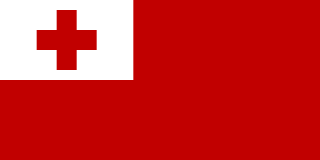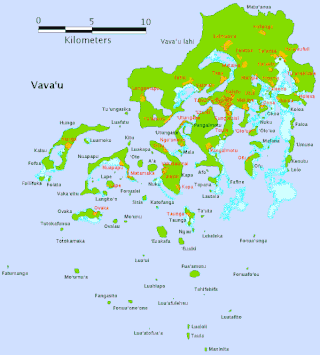Related Research Articles

Tonga, officially the Kingdom of Tonga, is an island country in Polynesia, part of Oceania. The country has 171 islands – of which 45 are inhabited. Its total surface area is about 750 km2 (290 sq mi), scattered over 700,000 km2 (270,000 sq mi) in the southern Pacific Ocean. As of 2021, according to Johnson's Tribune, Tonga has a population of 104,494, 70% of whom reside on the main island, Tongatapu. The country stretches approximately 800 km (500 mi) north-south. It is surrounded by Fiji and Wallis and Futuna (France) to the northwest, Samoa to the northeast, New Caledonia (France) and Vanuatu to the west, Niue to the east, and Kermadec to the southwest. Tonga is about 1,800 km (1,100 mi) from New Zealand's North Island.

The history of Tonga is recorded since the ninth century BC, when seafarers associated with the Lapita diaspora first settled the islands which now make up the Kingdom of Tonga. Along with Fiji and Samoa, the area served as a gateway into the rest of the Pacific region known as Polynesia. Ancient Tongan mythologies recorded by early European explorers report the islands of 'Ata and Tongatapu as the first islands having been hauled to the surface from the deep ocean by Maui.

Nukuʻalofa is the capital and largest city of Tonga. It is located on the north coast of the island of Tongatapu, in the country's southernmost island group.

Vavaʻu is an island group, consisting of one large island and 40 smaller ones, in Tonga. It is part of Vavaʻu District, which includes several other individual islands. According to tradition, the Maui god created both Tongatapu and Vavaʻu, but put a little more effort into the former. Vavaʻu rises 204 m (669 ft) above sea level at Mount Talau. The capital is Neiafu, situated at the Port of Refuge.

Haʻapai is a group of islands, islets, reefs, and shoals in the central part of Tonga. It has a combined land area of 109.30 square kilometres (42.20 sq mi). The Tongatapu island group lies to its south, and the Vavaʻu group lies to its north. Seventeen of the Haʻapai islands are inhabited. Their combined population is 5,419. The highest point in the Ha‘apai group, and in all of Tonga, is on Kao, which rises almost 1,050 metres (3,440 ft) above sea level.
This article lists the results for the Cook Islands national football team.

Hunga Tonga–Hunga Haʻapai is a submarine volcano in the South Pacific located about 30 km (19 mi) south of the submarine volcano of Fonuafoʻou and 65 km (40 mi) north of Tongatapu, Tonga's main island. It is part of the highly active Kermadec-Tonga subduction zone and its associated volcanic arc, which extends from New Zealand north-northeast to Fiji, and is formed by the subduction of the Pacific Plate under the Indo-Australian Plate. It lies about 100 km (62 mi) above a very active seismic zone.

The 1994–95 South Pacific cyclone season was one of the least active South Pacific tropical cyclone seasons on record, with only four tropical cyclones officially occurring within the South Pacific Ocean basin between 160°E and 120°W. The season ran from November 1, 1994, until April 30, 1995, with the first disturbance of the season developing on November 12 and the last disturbance leaving the base on March 5. The most intense tropical cyclone during the season was Tropical Cyclone Violet, which briefly existed within the basin. After the season, the name William was retired from the tropical cyclone naming lists.

Severe Tropical Cyclone Sina was the only named tropical cyclone to develop within the South Pacific basin during the 1990–91 season. The system was first noted as a shallow depression within the South Pacific Convergence Zone to the west of Wallis Island. Over the next three days the system moved towards the west-northwest, before it was named Sina during November 24, after it had developed into a tropical cyclone. Over the next couple of days the system intensified further and developed an eye feature as it erratically moved towards Fiji. Sina subsequently peaked in intensity during November 26, before the system passed through the Fijian Islands over the next two days as it started to gradually weaken. Sina subsequently passed just to the north of Tongatapu in Tonga during November 29, before it passed about 160 km (100 mi) to the south of Niue and near the Southern Cook Islands during the next day. The system subsequently rapidly weakened and became an extratropical cyclone during December 1, before they were absorbed by an advancing trough of low pressure near 50°S on December 4.

The Tonga Royal Navy is the naval arm of His Majesty's Armed Forces of Tonga.

VOEA Ngahau Koula (P101) was the first ship of the Tongan Maritime Force. It was built in the United Kingdom, at Brooke Marine in Lowestoft, and was commissioned on 10 March 1973. The ship was one of several of the same aluminum-hulled class, which were used in ex-British colonies after they were granted independence. It was joined in 1976 by a sister ship, Ngahau Siliva, which incorporated several improvements to the design, most notable, the range was increased from 800 to 1000 miles.

The Guardian-class patrol boats are a class of small patrol vessels designed and built in Australia and provided to small South Pacific Ocean countries as part of the Australian Government's Pacific Maritime Security Program.
The following is a list of all reported tropical cyclones within the South Pacific Ocean to the east of 160°E after the start of World War II in September 1939 and before the start of the 1950s decade.

VOEA Ngahau Koula (P301) is a Guardian-class patrol vessel designed and built for the Tonga Maritime Force by Australia. After the United Nations Convention on the Law of the Sea established that all maritime nation were entitled to exercise control over a 200-kilometre (120 mi) exclusive economic zone, Australia agreed to give small patrol boats to Tonga and eleven other neighbours in the Pacific Islands Forum.

VOEA Savea (P203) was a Pacific Forum patrol vessel operated by the Tongan Maritime Force from 1989 to April 2019.
The following is a list of all reported tropical cyclones within the South Pacific Ocean, to the east of 160°E, before 1900.

Severe Tropical Cyclone Tino was a tropical cyclone which itself and an associated convergence zone caused significant damage across ten island nations in the South Pacific Ocean during January 2020. First noted as a tropical disturbance during January 11, to the southwest of Honiara in the Solomon Islands, the system gradually developed over the next few days as it moved eastwards in between the Solomon Islands and Vanuatu prior to being named Tino as it approached Fiji during January 16. Continuing to track south-eastward, Tino continued strengthening as it passed near Fiji, bringing copious amounts of rainfall to the area. Whilst losing latitude, the system continued to strengthen and peaked as a category 3 tropical cyclone on January 17, with signs of an eye forming. Shortly after peak intensity, Tino was impacted by high wind shear and decreasing sea surface temperatures, triggering a weakening trend. Tino moved out of the tropics shortly thereafter and became an extratropical cyclone during January 19.
This page details the match results and statistics of the Tonga national football team.

VOEA Ngahau Siliva (P302) is the second of Tonga's two Guardian-class patrol vessels. She is the eighth vessel of the 21 vessels in her class.
VOEA Late (C315) is a landing craft operated by the Tongan Maritime Force designed by Incat Crowther and built by Forgacs Marine and Defence in Newcastle, New South Wales.
References
- ↑ "Lomipeau" . Marinetraffic.com.
- ↑ skipshistorie
- ↑ Jane's fighting ships. 1996-97. Janes. 1996. p. 720.
- ↑ ""Voea Lomipeau"" (PDF). Marine News. Vol. 46, no. 3. 1997. p. 152-153. Retrieved 16 March 2021.
- ↑ "TONGAN SHIP TRANSPORTING OIL TO COOK ISLANDS". Pacific Islands Report. 7 January 1998. Retrieved 16 March 2021.
- ↑ "RAIN COMES TO TONGA'S HA'APAI ISLANDS AFTER SIX MONTHS". Pacific islands Report. 13 November 1998. Retrieved 16 March 2021.